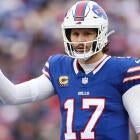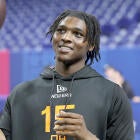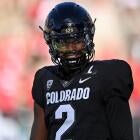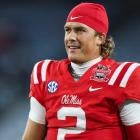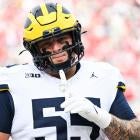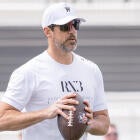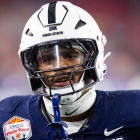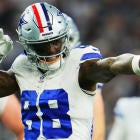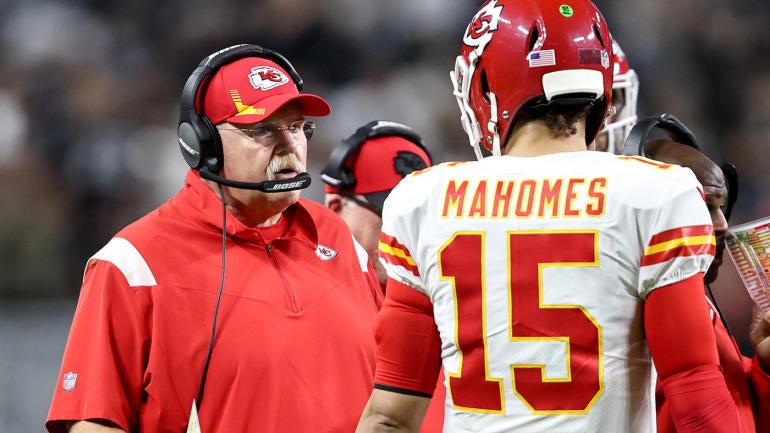
By now, most people following the NFL know that it is a passing league. Teams tend to rise and fall on the basis of their quarterback play. And for the most part, the teams who get the most surplus value out of their passers tend to have a better chance of competing than do their opponents.
Because this is true, it's important for teams that draft quarterbacks to put them in position to succeed right from the jump. They need to be surrounded by strong offensive lines, a deep and diverse group of pass-catchers, play-callers who scheme those pass-catchers open, and head coaches who can help shepherd their development from rookie to veteran and hopefully to stardom.
In recent years, it's become en vogue to prioritize having an offensive-leaning head coach (and play-caller) so you have the same voice in your young quarterback's ear as he develops. But does it really have a strong effect? That's what we set out to discover.
Between 2011 and 2020 -- a time period that covers the beginning of the new collective bargaining agreement that established the baseline for the current rookie contract scale through the draft class that became extension-eligible this offseason -- there were 36 quarterbacks that came into the league and made at least 25 starts while still on their rookie deal (not including the fifth-year option year). Among that group, 18 were drafted to a team with an offensive head coach, 17 were drafted to a team with a defensive head coach, and one (Lamar Jackson) was drafted to a team whose head coach was neither an offensive or defensive-leaning coach. (John Harbaugh was a longtime special teams coordinator, but also coached running backs, tight ends, outside linebackers, and defensive backs at different stops.)
The quality of those coaches ranged widely from Hue Jackson and Pat Shurmur to Andy Reid and Kyle Shanahan on offense, and Jeff Fisher and Jack Del Rio to Bill Belichick and Pete Carroll on defense.
| Offensive HC | Year | Pick | Team | Defensive HC | Year | Pick | Team |
| Colin Kaepernick | 2011 | 36 | 49ers | Cam Newton | 2011 | 1 | Panthers |
| Robert Griffin III | 2012 | 2 | Washington | Blaine Gabbert | 2011 | 10 | Jaguars |
| Ryan Tannehill | 2012 | 8 | Dolphins | Christian Ponder | 2011 | 12 | Vikings |
| Brandon Weeden | 2012 | 22 | Browns | Andy Dalton | 2011 | 35 | Bengals |
| Nick Foles | 2012 | 88 | Eagles | Andrew Luck | 2012 | 1 | Colts |
| Kirk Cousins | 2012 | 102 | Washington | Russell Wilson | 2012 | 75 | Seahawks |
| Marcus Mariota | 2015 | 2 | Titans | Geno Smith | 2013 | 39 | Jets |
| Trevor Siemian | 2015 | 250 | Broncos | Blake Bortles | 2014 | 3 | Jaguars |
| Carson Wentz | 2016 | 2 | Eagles | Teddy Bridgewater | 2014 | 32 | Vikings |
| Dak Prescott | 2016 | 135 | Cowboys | Derek Carr | 2014 | 36 | Raiders |
| Patrick Mahomes | 2017 | 10 | Chiefs | Jameis Winston | 2015 | 1 | Buccaners |
| Deshaun Watson | 2017 | 12 | Texans | Jared Goff | 2016 | 1 | Rams |
| Baker Mayfield | 2018 | 1 | Browns | Jacoby Brissett | 2016 | 91 | Patriots |
| Kyler Murray | 2019 | 1 | Cardinals | Mitchell Trubisky | 2017 | 2 | Bears |
| Daniel Jones | 2019 | 6 | Giants | Sam Darnold | 2018 | 3 | Jets |
| Joe Burrow | 2020 | 1 | Bengals | Josh Allen | 2018 | 7 | Bills |
| Justin Herbert | 2020 | 6 | Chargers | Tua Tagovailoa | 2020 | 5 | Dolphins |
| Jalen Hurts | 2020 | 53 | Eagles |
Helpfully, these two groups of players made almost the exact same number of starts during the course of their rookie deals. The 18 players drafted to offensive-coach teams combined to start 821 games, while the 17 quarterbacks drafted by defensive-coach teams started 823 games during the same period.
The teams with defensive coaches were afforded more highly-drafted players. On average, those quarterbacks were selected almost exactly 20 picks earlier than their offensive-coach counterparts, and more of them were selected at No. 1 overall, inside the top 5, inside the top 10, and on Day 2 (i.e. Rounds 2 and 3). The players drafted to offensive-leaning teams performed a bit better in terms of win-loss record, but by a margin that translates to only about a quarter of a win over the course of a 17-game season.
| Quarterbacks | Offensive HC | Defensive HC |
| Drafted | 18 | 17 |
| Avg Selection | 40.9 | 20.8 |
| No. 1 | 3 | 5 |
| Top 5 | 6 | 8 |
| Top 10 | 9 | 10 |
| Day 2 | 2 | 5 |
| Day 3 | 4 | 1 |
| Starts | 821 | 823 |
| Wins | 430 | 420 |
| Losses | 388 | 400 |
| Ties | 3 | 3 |
| Win % | 0.526 | 0.512 |
Taking a look at the passing stats is where the players drafted to teams with offensive head coaches begin to separate themselves. Those players completed their passes at a higher rate, averaged more yards per attempt, and saw their passes turn into touchdowns more often and interceptions less often, despite the fact that they faced a higher rate of pressure from opposing defenses.
They also averaged more expected points added (EPA) per dropback and created explosive plays (completions of 20-plus yards) more often despite throwing shorter passes in relation to both the line of scrimmage and the first-down marker than the counterparts. The offensive-coach quarterbacks were sacked on a slightly higher share of their dropbacks, but a slightly lower share of their pressured dropbacks, indicating that they were better able to navigate muddy pockets.
| Passing Stats | Offensive HC | Defensive HC |
| EPA/Dropback | 0.06 | 0.04 |
| Comp | 17,856 | 16,471 |
| Att | 27,898 | 26,977 |
| Comp % | 64.0% | 61.1% |
| Yds | 205,019 | 185,948 |
| YPA | 7.35 | 7.03 |
| TD | 1,277 | 1,178 |
| INT | 601 | 707 |
| TD % | 4.58% | 4.37% |
| INT % | 3.37% | 4.29% |
| QB Rating | 92.32 | 86.15 |
| Pressure % | 33.0% | 31.2% |
| Sack % | 6.45% | 6.16% |
| Yds/Sack | 6.56 | 6.43 |
| Sack/Pressure | 19.6% | 19.8% |
| Expl/DB | 8.23% | 7.92% |
| Air Yards/Att | 8.31 | 8.52 |
| AY2Sticks/Att | -0.66 | -0.48 |
| Deep % | 11.9% | 12.3% |
The players drafted to teams with offensive head coaches also out-performed their defensive counterparts as runners.
They averaged more yards per carry, saw their runs generate a higher success rate, were stopped at or behind the line of scrimmage on a smaller share of their attempts, gained 5-plus yards more often, generated an explosive play more often, and averaged more EPA per rush attempt. And they did all that despite a greater share of their runs being designed (as opposed to scrambles), even though those attempts tend to gain fewer yards because they are more like traditional run plays. The only area where the quarterbacks on defensive-coached teams out-performed the players with offensive coaches was in yards after contact per attempt, but they did so by just north of one-one-hundredth of a yard per carry.
| Rushing Stats | Offensive HC | Defensive HC |
| Rush | 3610 | 3402 |
| Yards | 18138 | 16278 |
| Yds/Rush | 5.02 | 4.78 |
| YBCo/Att | 2.97 | 2.77 |
| YCO/Att | 2.05 | 2.06 |
| EPA/Rush | 0.10 | 0.08 |
| Success % | 41.1% | 37.3% |
| Negative % | 25.4% | 27.0% |
| 5+ Yd % | 43.0% | 42.1% |
| Explosive % | 12.3% | 11.7% |
| Design % | 56.4% | 51.6% |
There are, of course, a few caveats to consider here.
For instance, we are only accounting for the leanings of the head coach at the time the players were drafted. Some of these players made a significant number their rookie-contract starts for entirely different teams, like Nick Foles and Jacoby Brissett. Some of them made most of their starts under a different coach from the one who was in place at the time they were drafted, like Ryan Tannehill, Marcus Mariota, Baker Mayfield, Daniel Jones, Justin Herbert, Jalen Hurts, Blaine Gabbert, Christian Ponder, Blake Bortles, Derek Carr, Jared Goff, Mitchell Trubisky, and Sam Darnold.
Some of those players (like Herbert, Carr, Goff, and Tua Tagovailoa) saw their most success with coaches who had specialties on the opposite side of the ball from those with whom they began their careers. And perhaps most obviously, some of these players (like Patrick Mahomes and Russell Wilson) were dropped into enviable situations given their team surroundings, while others (like Brandon Weeden and Sam Darnold), were, uh, not.
We're also only looking at collective performance over the entirety of these players' rookie deals, and not their year-to-year progression or anything they have done after signing their second (or third) contracts. Players like Tannehill, Kirk Cousins, Andy Dalton, and Geno Smith did some of their best work in Years 5 through 10 of their careers. Players like Dak Prescott, Mahomes, and Allen are now on their second deals and playing quite well, while players like Carson Wentz and Russell Wilson have been paid multiple times and eventually saw their play regress for some reason or another.
So, it's tough to say that the players drafted to teams with offensive-leaning head coaches succeeded specifically because they were drafted to teams with offensive leaning head coaches. Correlation does not equal causation, after all. But they did outperform them, and perhaps that's worth considering in the context of the quarterbacks who have come into the league over the past few seasons.
That group of players consists of Trevor Lawrence, Zach Wilson, Trey Lance / Brock Purdy, Justin Fields, Mac Jones, Davis Mills, Kenny Pickett, Desmond Ridder, Sam Howell, Bryce Young, C.J. Stroud, Anthony Richardson, and Will Levis. A couple of those players (Wilson and Mills) have already been definitively usurped. Another (Lance) may or may not have been, depending on the status of Purdy's elbow. Three of them (Pickett, Ridder, and Howell) are entering their first full season as the starter, and four are rookies.
Among them, eight (Lawrence, Lance, Purdy, Fields, Mills, Ridder, Young, and Richardson) were drafted to teams with offensive-leaning head coaches at the time, but two of those teams have already changed coaches and seen the players perform far better under their new tutelage, while one is already out of a job and another might be. The remaining six players (Wilson, Jones, Pickett, Howell, Stroud, and Levis) were drafted to teams with defensive-leaning coaches, but we know far less about that group at this point because Jones is the only one who has made a significant number of starts and still has his spot under center. And he regressed badly when given a new "offensive coordinator" last season.
The development of this group of players can grow the sample size of quarterbacks listed above by as much as 40% (14 quarterbacks compared to the 35 we studied), so it can have a strong effect on what we might think coaching priorities should be as we head deeper into the second decade of the rookie-contract scale.
![[object Object] Logo](https://sportshub.cbsistatic.com/i/2020/04/22/e9ceb731-8b3f-4c60-98fe-090ab66a2997/screen-shot-2020-04-22-at-11-04-56-am.png)









